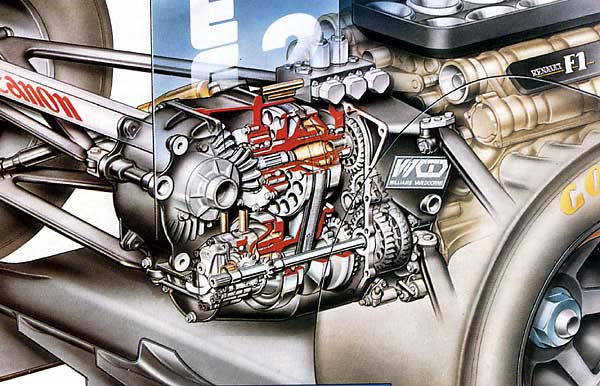If you use a electric engine it will require more power when you acelerate.
To suply more power the load on the stirling has to increase and because of the stirlings slow response to load changing it would drop in speed (just read about diesel generator's and speed drop).
A battery package would prevent this, but ad extra weight.[/quote}
Correct, btu if it is only required for short periods it does NOT as larege a penalty. It's only needed for averaging the peak needs withthe average output fo a VERY efficient engine. I thought that was obvious

Careful.
DAF had been racing the CVT inf F3 - we've talked abotu it before on UCP with pics - and Frank worked with them to TEST it. Whether it actually delevered any benefit for the weight and stresses was never published and the FIA banned it before it
DC test drove the one in '93

The FIA banned CVT as they felt it took away from the driver. Not for technical reasons. So it never went any further. So we never knew whether it was able to handle the torque lash of kerbs corner on full throttle or if it lasted 2 hours.
Where did you find a reference to it actually HANDLING the 700HP for duration ???
It's NOT easy to "balance" an engine. Even the best balancer shafts have recognised frequencies in the engine where they are inneffective due to harmonics.
But the Revetec doesnt' need contra-rotating balanceshafts as it isnt' trying to balance a ROTATING mass. You dont' seem to grasp the difference

By the time you get to the point in the curve you have used up ( or should have ) the expansion of the gasses - with a little left over to assist exhaust flow ). So you are mathematically correct if you were running an engine driven by compressed air. But you're not. You are running a COMBUSTION engine which has a peak pressure which drops as the piston recedes. As I said before, you seem to only see one thing at a time. Each thing on it's own is valid. BUT when you take the other factors into account aren't .
They're not. THere are plenty of companies producing new engines on a regular basis.
PS: 2-strokes can't clean up emissions without major post combustion management. You can't burn heavy lubricating oils wihtout emission problems. Sadly nobody wants to invest in finding solutions.
Originally Posted by stian1979








 Reply With Quote
Reply With Quote